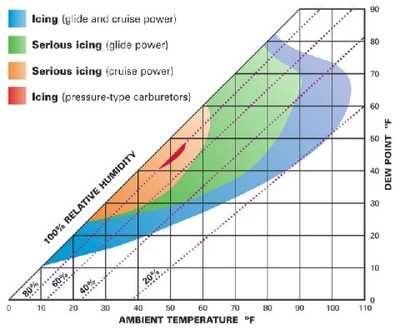Wed, Jul 01, 2009
Summer Means Higher Humidity, And A Chance For Ice
 The FAA has issued
a Special Airworthiness Information Bulletin designed to
inform pilots of the potential hazards associated with carburetor
icing. For now, this airworthiness concern is not considered an
unsafe condition that would warrant an AD, but is still a timely
reminder for summer flying.
The FAA has issued
a Special Airworthiness Information Bulletin designed to
inform pilots of the potential hazards associated with carburetor
icing. For now, this airworthiness concern is not considered an
unsafe condition that would warrant an AD, but is still a timely
reminder for summer flying.
The FAA says there were 212 accidents attributed to carburetor
icing between 1998 and 2007. Of these accidents,13 resulted in
fatalities. The certification requirements for carbureted airplanes
require that a heated source of air be provided as mitigation for
carburetor icing. The FAA and the Aircraft Owners and Pilots
Association (AOPA) have addressed the subject of carburetor icing
several times in various forms. Despite the certification
requirements, and the information provided by the FAA and AOPA, the
accident trend has remained fairly steady throughout the years.
Pilots should be aware that carburetor icing doesn’t just
occur in freezing conditions, it can occur at temperatures well
above freezing temperatures when there is visible moisture or high
humidity. Icing can occur in the carburetor at temperatures above
freezing because vaporization of fuel, combined with the expansion
of air as it flows through the carburetor, (Venturi Effect) causes
sudden cooling, sometimes by a significant amount within a fraction
of a second. Carburetor ice can be detected by a drop in rpm in
fixed pitch propeller airplanes and a drop in manifold pressure in
constant speed propeller airplanes. In both types, usually there
will be a roughness in engine operation. The graph below shows the
probability of carburetor icing for various temperature and
relative humidity conditions:

There are some steps a pilot can take to prevent, recognize, and
respond to carburetor icing. To prevent carburetor icing, the pilot
should:
- Assure the proper functionality of the carburetor heat during
the preflight check.
- Use carburetor heat on approach and descent when operating at
low power settings, or in conditions where carburetor icing is
probable.
To recognize carburetor icing, the warning signs are:
- A drop in rpm in fixed pitch propeller airplanes.
- A drop in manifold pressure in constant speed propeller
airplanes.
- In both types, usually there will be a roughness in engine
operation.
The pilot should respond to carburetor icing by applying full
carburetor heat immediately. The engine may run rough for short
time while ice melts. The FAA says these recommendations are
general suggestions. The pilot should consult the AFM or the
pilot's operating handbook for the proper use of carburetor
heat.
More News
Aero Linx: Aviators Code Initiative (ACI) Innovative tools advancing aviation safety and offering a vision of excellence for aviators. The ACI materials are for use by aviation pra>[...]
Make Sure You NEVER Miss A New Story From Aero-News Network Do you ever feel like you never see posts from a certain person or page on Facebook or Instagram? Here’s how you c>[...]
From 2016 (YouTube Edition): Who You Gonna Call When You Have a Rocket Engine that Needs a Spacecraft? While at EAA AirVenture 2016, ANN CEO and Editor-In-Chief, Jim Campbell, sat >[...]
"In my opinion, if this isn't an excessive fine, I don't know what is... The odds are good that we're gonna be seeking review in the United States Supreme Court. So we gotta muster>[...]
Expedite Used by ATC when prompt compliance is required to avoid the development of an imminent situation. Expedite climb/descent normally indicates to a pilot that the approximate>[...]
 ANN's Daily Aero-Linx (04.30.25)
ANN's Daily Aero-Linx (04.30.25) ANN FAQ: Turn On Post Notifications
ANN FAQ: Turn On Post Notifications Classic Aero-TV: Agile Aeros Jeff Greason--Disruptive Aerospace Innovations
Classic Aero-TV: Agile Aeros Jeff Greason--Disruptive Aerospace Innovations Aero-News: Quote of the Day (04.30.25)
Aero-News: Quote of the Day (04.30.25) ANN's Daily Aero-Term (04.30.25): Expedite
ANN's Daily Aero-Term (04.30.25): Expedite




